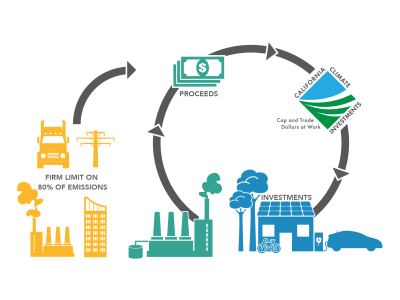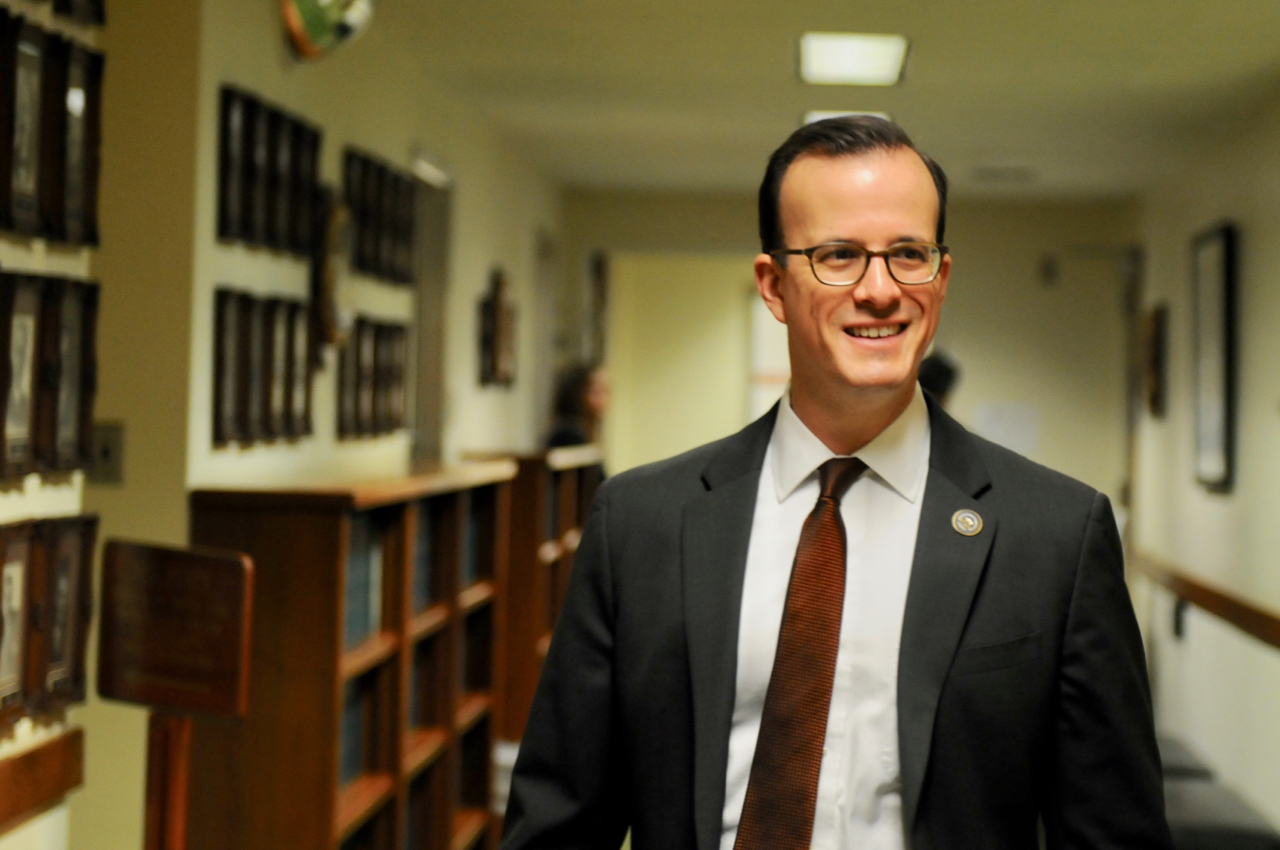
Cap and Trade Program, California Air Resources Board. (Photo: CARB.ca.gov)
California’s Cap and Trade Runs Out of Emissions….and Money for Pet Political Projects
‘It’s not the emissions but the revenue that concerns the Legislature’
By Wayne Lusvardi, July 9, 2020 11:47 am
“Be careful what you wish for. You might get it” said the proverbial Aesop (260 B.C.) in one of his ancient Greek fables. Something like this is playing out with the California Legislature that is getting just what it said it wanted when it passed the Global Warming Solutions Act of 2006 in Assembly Bill 32, which created the state’s Cap and Trade Program to reduce greenhouse gas emissions (GHG’s) from polluting industries. But lawmakers are just now learning that if you run out of emissions, you run out of revenues.
Cap and Trade was devised to gradually reduce industrial emissions to the level that existed in 1990. Anything over the emission targets would require industries to buy or trade pollution permits (called “allowances”) in a quarterly market auction, rather than paying pollution fines or taxes.
Due to the government-created coronavirus business shutdowns, California’s greenhouse gas emissions are reported to have fallen the most since World War II (minus 5% in 4 months), which is what environmentalists have long said they wished for. But along with this drop, Cap and Trade revenues from industrial purchases of pollution allowances dropped from $600-$850 million per quarter in 2019 to $25 million in May 2020 – a 97 % decrease.
These revenues are used to fund 25 percent of the California High Speed Rail project and a number of non-profit agencies in disadvantaged communities involved in “improving public health.”
In response, on March 1, California Senators Ben Allen, D-Santa Monica, and Bill Monning, D-Carmel, and state Assemblywoman Christina Garcia, D-Bell Gardens, sent a letter to the Secretary of the California Environmental Protection Agency, Jared Blumenthal, purporting to be concerned about Cap and Trade meeting its air quality objectives during the business shutdown. Specifically, the letter asked if too many emission permits had been sold in an economy artificially depressed by business shutdowns due to the virus panic? Assemblywoman Christina Garcia stated: “The legislature, the nonprofits, the activists now need to figure out how to take advantage of this opportunity.”
On April 22, Blumenthal and Mary Nichols, head of the California Air Resources Board, replied: “GHG emissions in California have declined faster than anticipated. This decline will yield unused allowances at the end of 2020.” Blumenthal further stated Cal-EPA would undertake a comprehensive review of the Cap and Trade Program to ascertain if it required modification even though emissions have dropped beyond their wildest dreams.
To understand more about the proposed revisions to the Cap and Trade program, California Globe interviewed Tom Tanton, Director of Science and Technology Assessment for the Energy and Environmental Legal Institute, and former principal policy advisor to the California Energy Commission.
Question 1: The legislature has been asked to evaluate revising the Cap and Trade program now that revenues have fallen, despite a simultaneous historic drop in emissions.
Tanton: “It is astounding that the legislature is surprised, as the program is designed and intended to reduce emissions, which has happened, however, for entirely different reasons.”
Question 2: Now the legislature wants to covertly find a way to increase revenues during what may be a prolonged economic depression to fund the legislature’s pet political projects and patrons without calling it a tax.
Tanton: “A rose by any other name would smell as sweet.”
Question 3: It is interesting that emissions have dropped to an historic low due to virus epidemic shutdowns of the economy.
Tanton: “I believe this standard was met earlier without the virus.”
Question 4: Apparently CARB never factored a (man-made) economic depression into their program models.
Tanton: “Nor many other emission-reducing factors. Nor did they consider an emission increasing factor (actually a slower reduction) due to government ineptitude in ‘fighting a market failure.’”
Question 5: California’s Cap & Trade Program pollution allowances to private industry dropped from $600 million in February 2020 at its February auction to $25 million out of $57 million worth of pollution permits auctioned at its May auction. In its Cap & Trade Program design was a man-made economic depression accounted for?
Tanton: “Nor many other emission-reducing factors. Nor did they consider an emission increasing factor (actually a slower reduction) due to government ineptitude in ‘fighting a market failure.’ Nor were technological advances. The earlier, Great recession in 2008, resulted in emission targets in AB32 being met, but the program had to continue.”
Question 6: In a few words, what are some of the more cost-effective ways to reduce greenhouse gas emissions in the upper atmosphere (not same as visual smog)?
Tanton: “For any measure to be ‘cost effective,’ the cost of reduction needs to be less than the benefit from reduction. The latter is typically measured by the ‘social cost of carbon.’ Some simple measures like improving the efficiency of power plants can go long way to reducing emissions, but are difficult to implement when other favored, but sporadic, technologies like wind and solar cause them to operate like your car in stop-and-go-traffic…way lower efficiency and way higher emissions. Allowing power plants to operate more in a steady state would be one way. Another way would be to increase water allotments to farmers, rather than flushing it out to sea, allowing them to increase crop production… that photosynthesis eats up carbon pretty well.”
Question 7: One of the proposed reforms in the 334-page proposal to amend the program is to set up a system of so-called market floating prices for pollution permits. By withholding allowances from the market prices rise and as allowances are released prices fall. But currently the way prices are set for allowances is by regulatory fiat, not markets. Then why is this called a market program?
Tanton: “Well, if you listen carefully they often say ‘market-like.’ A true market is a set of willing sellers and willing buyers. The former is missing entirely, while the latter is pretty iffy. The fiats were implemented to avoid real chaos emulating the 2000 energy crisis.”
Question 8: If there is another consecutive low revenue auction, wouldn’t that result in a lot of price unpredictability?
Tanton: “There is no doubt it’s there. Another low revenue auction would wake those still enamored with it to its ludicrous nature. It would also likely be a lagging indicator of business flight from California. Less snarky, it may just be an indicator of the on-going re-structuring of the California economy (less making, more doing. Less manufacturing and more services) to less carbon intensive activities. I’ve always said AB32 was industrial policy more so than environmental.”
Question 9: Data I found says 13,000 businesses have moved out of California since 2007. To what degree are emissions decreasing due to cap & trade and to relocations?
Tanton: “Ahh, there’s the rub. Emissions are not decreasing due to cap and trade, in my humble opinion. Emissions that continue are just paid for through a system of indulgences. (that’s what cap and trade does, but makes you pay for them.) Relocations, if they are a relocation and not a shut down, just continue the emissions but elsewhere (in the businesses new location). That, my friend, is called ‘leakage.’ There are two types: economic leakage (jobs and GSP) and emissions leakage (emissions.) But the emissions are of global import, sayeth the AGW crowd and matters not if they occur in-state or in, say, Idaho or Indonesia. It’s just virtue signaling.”
Question 10: New Assembly Bill 398 limits the allowances that industries can use to offset pollution that is estimated will result in a $16 billion increase ($4 billion per quarter) in Cap and Trade revenues. How will this new revenue generating formula work out?
Tanton: “Part of the problem is that the compliance mechanism is so complex and sensitive to minor perturbations, so the politicians’ answer is to make it more complex and sensitive? The foundation upon which the courts decided Cap and Trade was not a tax was an argument that it was a fee for permission to emit. That seems to have all but been forgotten. The diminution of offsets as a way to control emissions, in order to maintain state revenue levels, pretty clearly shows it’s not the emissions but the revenue that concerns the Legislature.”
- Peter Gleick’s National Water Plan for California - October 12, 2020
- Court Opens Up Big Prop.13 Loophole for ‘Public Franchise Fees’ - October 2, 2020
- New Cal Grid CEO is Ex-Enron Green Power Trader - September 29, 2020








Air quality and global warming are nothing but revenue schemes that also depress economic activity which then “justifies” ever increasing taxation. Democrats would call this a win-win situation.
The Green Delusion continues to Perpetuate Costs upon the Poor – By withholding disturbing data, the “Greenies” are convincing the public to financially support the climate cult.
It’s not that COVID-19 and the economic meltdown that’s occurred has resulted in the public ignoring climate policies, it’s that the meltdown has put major emphasis on the extraction of exotic minerals to support wind, solar, and EV batteries that imposes social challenges, human rights abuses, and environmental degradations worldwide. The green climate cult continues to perpetuate costs upon the poor and suppresses any information that would damage their message that green is “clean, renewable and sustainable”.
https://www.foxandhoundsdaily.com/2020/06/the-green-delusion-continues-to-perpetuate-costs-upon-the-poor/